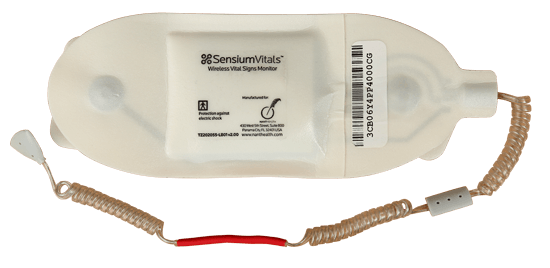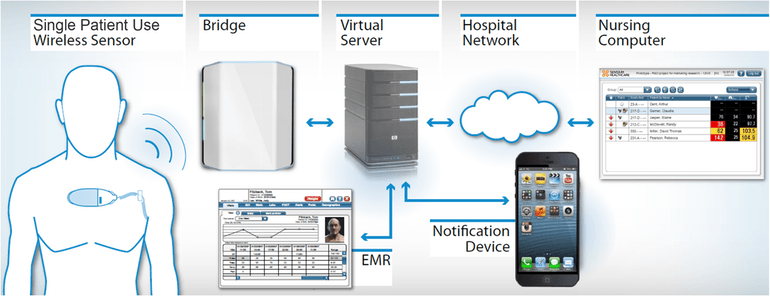
The monitoring of vital signs, such as pulse rate, respiration rate and body temperature, is an essential component of patient assessment. Changes in vital signs can be indicators of deterioration in a patient’s condition. However, in general care areas of the hospital, vital signs are typically taken during routine observation rounds only once every four to eight hours. If a patient deteriorates between these observation rounds, the warning signs can go undetected for hours, leading to potentially serious and costly consequences. Some hospitals are even leaning toward keeping patient nighttime interruptions to a minimum and are recommending avoiding the taking of vital signs after 11 pm to allow for maximum patient rest.
SensiumVitals is a revolutionary new wireless early warning system designed to improve patient outcomes and shorten hospital stays. The system, developed in the UK and introduced to the US market, enables early intervention by continuously and accurately monitoring vital signs of heart rate, respiration rate and axillary temperature every two minutes and alerting the nursing staff when pre-set thresholds are exceeded. The system is based on a disposable, single-use, wearable patch that monitors patients outside of high acuity areas. By notifying clinicians of changes in patients’ vital signs, SensiumVitals brings the nurse to the deteriorating patient, allowing intervention before the condition worsens, resulting in improved patient outcomes, shorter hospital stays, and lower treatment costs. It is currently in trials in two leading National Health Service (NHS) hospitals at St. James’s University Hospital in Leeds and Queen Elizabeth Hospital in Birmingham.
According to Anthony Sethill, CEO of Sensium Inc., “Patients can be tracked and monitored unobtrusively and continuously in real time when wearing the patch. A preliminary study of SensiumVitals monitored patients reported that hospital stays were shortened with additional cost savings on overall treatment.”
SensiumVitals communicates the patient measurements, which are interpreted by algorithms to avoid false alerts, for up to five days without the need for re-charging. The system utilizes a very low power radio to transmit the patient’s information, instead of using much more power hungry Wi-Fi or Bluetooth solutions.
SensiumVitals Wearable Path Overview

The SensiumVitals digital wearable patch is an FDA-cleared, lightweight (weighing only ½ ounce), energy-efficient, battery-powered device that uses a proprietary digital radio chip to monitor a patients’ vital signs. It is designed for in-hospital use, particularly in general care, post-surgical areas, and emergency rooms, and can be easily attached to the patient’s chest by means of two self-adhesive conventional ECG electrodes. Getting patients up and mobile is key to faster recovery times and fewer complications. The SensiumVitals patch has unique roaming capabilities that means that patients’ vital signs can be transmitted as they move around.

The SensiumVitals patch is easily integrated with existing hospital technology via a router-like “bridge” to the hospital IT system that reports to a nurses’ station, central monitoring station or any point-of-care Microsoft-based Web-enabled device, including hand-held devices for instant communications. The patch is discarded when the patient is discharged, removing the need for cleaning and sterilization to prevent cross-contamination. “Patient deterioration can result in serious health consequences, which may have been averted by an early warning indicator, such as the SensiumVitals patch,” continued Mr. Sethill.
When the patch is activated, it records respiratory and ECG activity in a sequential and cyclical fashion. Once a physiological signal is fully acquired, it is processed by its associated embedded algorithm inside the inbuilt processing unit, which results in transmission of the average values, i.e. heart rate as beats per minute (bpm) or respiratory rate as breaths per minute (brpm) to the nearest bridge for onward transmission to the central monitoring system. Furthermore, the algorithms on the chip are energy efficient and afford comparable accuracy to that of other types of monitoring devices. In addition, the system is embedded with a noise-detection strategy capable of automatically detecting and discarding erroneous calculations that arise from respiratory and ECG signals severely corrupted by electrical or motion artifacts.

